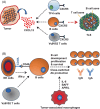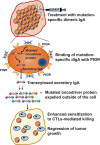B cell responses and antibody-based therapeutic perspectives in human cancers
- PMID: 38522010
- PMCID: PMC10961090
- DOI: 10.1002/cnr2.2056
B cell responses and antibody-based therapeutic perspectives in human cancers
Abstract
Background: Immuno-oncology has been focused on T cell-centric approaches until the field recently started appreciating the importance of tumor-reactive antibody production by tumor-infiltrating plasma B cells, and the necessity of developing novel therapeutic antibodies for the treatment of different cancers.
Recent findings: B lymphocytes often infiltrate solid tumors and the extent of B cell infiltration normally correlates with stronger T cell responses while generating humoral responses against malignant progression by producing tumor antigens-reactive antibodies that bind and coat the tumor cells and promote cytotoxic effector mechanisms, reiterating the fact that the adaptive immune system works by coordinated humoral and cellular immune responses. Isotypes, magnitude, and the effector functions of antibodies produced by the B cells within the tumor environment differ among cancer types. Interestingly, apart from binding with specific tumor antigens, antibodies produced by tumor-infiltrating B cells could bind to some non-specific receptors, peculiarly expressed by cancer cells. Antibody-based immunotherapies have revolutionized the modalities of cancer treatment across the world but are still limited against hematological malignancies and a few types of solid tumor cancers with a restricted number of targets, which necessitates the expansion of the field to have newer effective targeted antibody therapeutics.
Conclusion: Here, we discuss about recent understanding of the protective spontaneous antitumor humoral responses in human cancers, with an emphasis on the advancement and future perspectives of antibody-based immunotherapies in cancer.
Keywords: antibody‐based immunotherapies; immunoglobulin class‐switching; tumor microenvironment; tumor‐infiltrating B lymphocytes.
© 2024 The Authors. Cancer Reports published by Wiley Periodicals LLC.
Conflict of interest statement
The authors do not have any conflict of interest.
Figures


Similar articles
-
Unraveling spontaneous humoral immune responses against human cancer: a road to novel immunotherapies.J Leukoc Biol. 2024 Nov 4;116(5):919-926. doi: 10.1093/jleuko/qiae179. J Leukoc Biol. 2024. PMID: 39190797 Review.
-
NY-ESO-1 Based Immunotherapy of Cancer: Current Perspectives.Front Immunol. 2018 May 1;9:947. doi: 10.3389/fimmu.2018.00947. eCollection 2018. Front Immunol. 2018. PMID: 29770138 Free PMC article. Review.
-
Immuno-oncology: understanding the function and dysfunction of the immune system in cancer.Ann Oncol. 2012 Sep;23 Suppl 8(Suppl 8):viii6-9. doi: 10.1093/annonc/mds256. Ann Oncol. 2012. PMID: 22918931 Free PMC article. Review.
-
Clinically feasible approaches to potentiating cancer cell-based immunotherapies.Hum Vaccin Immunother. 2015;11(4):851-69. doi: 10.1080/21645515.2015.1009814. Hum Vaccin Immunother. 2015. PMID: 25933181 Free PMC article. Review.
-
CAR-modified immune cells as a rapidly evolving approach in the context of cancer immunotherapies.Med Oncol. 2023 Apr 21;40(5):155. doi: 10.1007/s12032-023-02019-4. Med Oncol. 2023. PMID: 37083979 Free PMC article. Review.
Cited by
-
A Bibliometric Analysis of Metabolic Reprogramming in the Tumor Microenvironment From 2003 to 2022.Cancer Rep (Hoboken). 2024 Aug;7(8):e2146. doi: 10.1002/cnr2.2146. Cancer Rep (Hoboken). 2024. PMID: 39158178 Free PMC article. Review.
References
-
- Richards CH, Flegg KM, SD Roxburgh C, et al. The relationships between cellular components of the peritumoural inflammatory response, clinicopathological characteristics and survival in patients with primary operable colorectal cancer. Br J Cancer. 2012;106:2010‐2015. doi:10.1038/bjc.2012.211 - DOI - PMC - PubMed
Publication types
MeSH terms
Substances
Grants and funding
LinkOut - more resources
Full Text Sources
Medical

